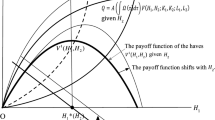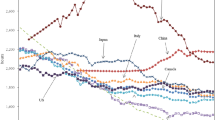Abstract
This paper analyzed the evolution of human capital inequality in an overlapping generations model that incorporates Stone–Geary preferences with subsistence consumption. Many studies have revealed an inverted U-shaped relationship between human capital inequality and economic development, namely the human capital Kuznets curve. However, this curve is inconsistent with empirical evidence in a US context, where the data suggest a U-shaped evolution of earnings inequality. We show that the utility function has an increasing elasticity of substitution, and the time allocated to human capital investment decreases in the early stages of human capital accumulation and increases afterward. Thus, we obtain a U-shaped curve for human capital inequality if the elasticity of substitution is large. Eventually, decreasing returns to human capital accumulation reduce inequality.



Similar content being viewed by others
References
Baumgärtner, S., Drupp, M. A., Quaas, M. F. (2013). Subsistence and substitutability in consumer preferences. Technical report, Working Paper Series in Economics.
Geary, R. C. (1950). A note on a constant-utility index of the cost of living. The Review of Economic Studies, 18(1):65–66.
Glomm, G., & Ravikumar, B. (1998). Increasing returns, human capital, and the kuznets curve. Journal of Development Economics, 55(2):353–367.
Glomm G., & Ravikumar, B. (2003). Public education and income inequality. European Journal of Political Economy, 19(2):289–300.
Kopczuk, W., Saez, E., & Song, J. (2010). Earnings inequality and mobility in the united states: evidence from social security data since 1937. The Quarterly Journal of Economics, 125(1), 91–128.
Koskela, E., & Puhakka, M. (2007). Stone-geary preferences in overlapping generations economies under pure exchange: A note. Journal of Macroeconomics, 29(4), 976–982.
Kraay, A., & Raddatz, C. (2007). Poverty traps, aid, and growth. Journal of Development Economics, 82(2), 315–347.
Kuznets, S. (1955). Economic growth and income inequality. The American economic review, 45(1), 1–28.
Matsuo, M., & Tomoda, Y. (2012). Human capital kuznets curve with subsistence consumption level. Economics Letters, 116(3), 392–395.
Ravn, M. O., Schmitt-Grohé, S., & Uribem, M. (2008). Macroeconomics of subsistence points. Macroeconomic Dynamics, 12(S1):136–147, 2008.
Steger T. M. (2000). Economic growth with subsistence consumption. Journal of Development Economics, 62(2):343 – 361.
Stone, R. (1954). Linear expenditure systems and demand analysis: an application to the pattern of british demand. The Economic Journal, 64(255), 511–527.
Strulik, H. (2010). A note on economic growth with subsistence consumption. Macroeconomic Dynamics, 14(5), 763–771.
Funding
This research received no specific grant from any funding agency in the public, commercial, or not-for-profit sectors.
Author information
Authors and Affiliations
Corresponding author
Ethics declarations
Conflicts of Interest
The author declares that he has no conflict of interest
Additional information
Publisher’s Note
Springer Nature remains neutral with regard to jurisdictional claims in published maps and institutional affiliations.
Appendix: Derivation of \(\sigma (n_{i,t},c_{i,t+1})\)
Appendix: Derivation of \(\sigma (n_{i,t},c_{i,t+1})\)
From \(MRS_{i,t}=\left( \frac{c_{i,t+1}-\bar{c}}{n_{i,t}} \right) ^\theta =\left[ \frac{c_{i,t+1}}{n_{i,t}}\left( 1-\frac{\bar{c}}{c_{i,t+1}} \right) \right] ^\theta\), we have
such that
From Eqs. 11 and 12, \(\sigma (n_{i,t},c_{i,t+1})\) can be expressed as follows:
To calculate the remaining derivative \(\frac{d(1-\bar{c}/c_{i,t+1})}{d(c_{i,t+1}/n_{i,t})}\), we transform the problem from the standard variables \((n_{i,t},c_{i,t+1})\) into variables \((\phi _{i,t},\upsilon _{i,t})\), as follows:
where \(\phi _{i,t}\) is the ratio of \(c_{i,t+1}\) to \(n_{i,t}\) and \(\upsilon _{i,t}\) is a monotonic transformation of utility. The elasticity of substitution measures substitutability between \(n_{i,t}\) and \(c_{i,t+1}\) along an indifference curve. Hence, we use \(u(n_{i,t},c_{i,t+1})=constant\) or \(d\upsilon _{i,t}=0\).
From Eqs. 14 and 15, we obtain \(1-\frac{\bar{c}}{c_{i,t+1}}=\left[ \frac{(1-\theta )\upsilon _{i,t}}{c_{i,t+1}^{1-\theta }}-\phi _{i,t}^{\theta -1} \right] ^{\frac{1}{1-\theta }}\). Therefore,
From Eqs. 14 and 15, we have \(\upsilon _{i,t}=\frac{(c_{i,t+1}/\phi _{i,t})^{1-\theta }+(c_{i,t+1}-\bar{c})^{1-\theta }}{1-\theta }\). Setting \(d\upsilon _{i,t}=0\) yields
Combining Eqs. 13 through 17, we have
From \(MRS_{i,t}=\left( \frac{c_{i,t+1}-\bar{c}}{n_{i,t}} \right) ^\theta\), \(n_{i,t}=(c_{i,t+1}-\bar{c})MRS_{i,t}^{-\frac{1}{\theta }}\). Plugging this into Eq. 18 yields Eq. 2.
Rights and permissions
About this article
Cite this article
Murayama, Y. Human Capital Inequality with Subsistence Consumption. J Knowl Econ 13, 2127–2137 (2022). https://doi.org/10.1007/s13132-021-00807-9
Received:
Accepted:
Published:
Issue Date:
DOI: https://doi.org/10.1007/s13132-021-00807-9




